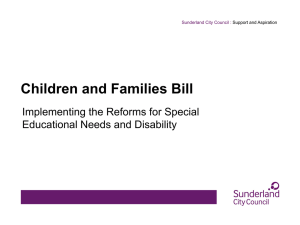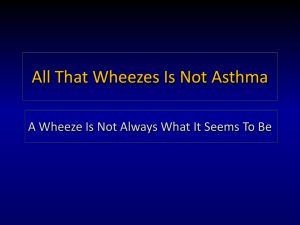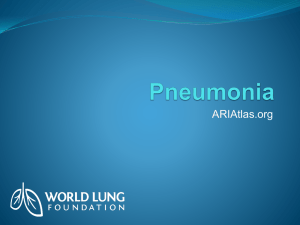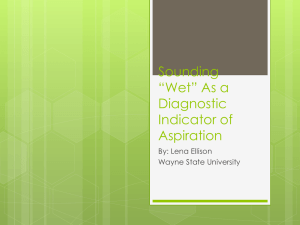Aspiration Pneumonia/Pneumonitis (When to Treat)
advertisement
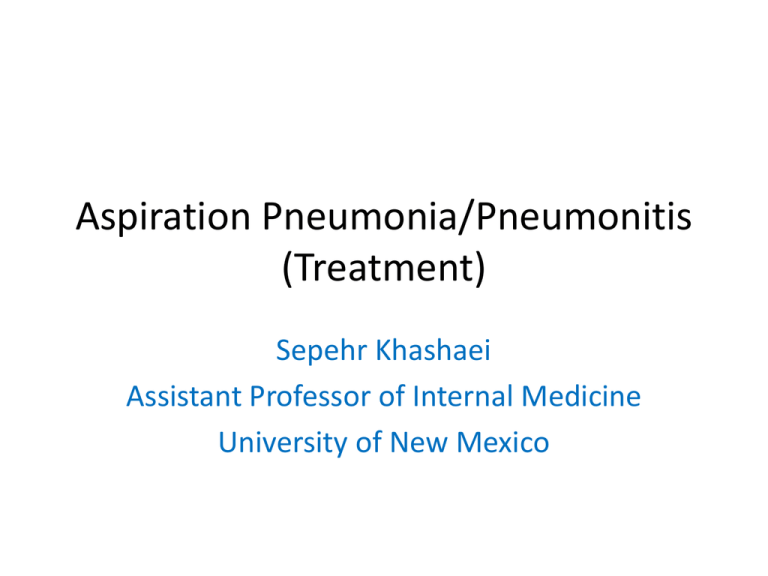
Aspiration Pneumonia/Pneumonitis (Treatment) Sepehr Khashaei Assistant Professor of Internal Medicine University of New Mexico • Aspiration is a common event even in healthy individual and usually resolves without detectable sequelae. • Most pneumonia arises following the microaspiration of organisms from the oral cavity or nasopharynx. • The pathogens that commonly produce pneumonia, such as streptococcus pneumoniae, H. influenzae, gram-negative bacilli, and Staph aureus, are relatively virulent bacteria so that only a small inoculum is required and the aspiration is usually subtle. Classification of aspiration syndromes • Aspiration (chemical) pneumonitis • Secondary bacterial infection of chemical pneumonitis • Primary bacterial aspiration pneumonia • Aspiration pneumonia/pneumonitis statistics (overall incidence is hard to ascertain): 5-15% of CAP 18% of pneumonias in nursing home residents Aspiration pneumonitis occurs in approximately 10% of patients who are hospitalized after a drug overdose. Aspriration pneumonitis is a complication of general anesthesia, occurring in approximately 1 of 3,000 operations in which anesthesia is administered and accounting for 10-30 % of all deaths associated with anesthesia. • In most aspirations, CXR or CT scan usually show infiltrate in the most dependent regions of the lung: –If aspiration occurs while the patient is supine, the posterior segments of the upper lobes and the apical segments of the lower lobes are most affected. –If aspiration occurs while the patient is upright, the basal segments of the lower lobes are most affected. • Conditions that predispose to aspiration pneumonia: – Reduced consciousness (cause decreased cough reflux and compromise in glottis closure): e.g. HE, alcohol, drugs, etc. – Dysphagia from neurologic deficits – Gastric reflux/esophageal disease – Surgery involving the upper airway or esophagus – Endotracheal intubation – Bronchoscopy/upper endoscopy – Nasogastric/gastrostomy feeding especially with recombent position – Protracted vomiting • A history of coughing while eating or drinking is likely to indicate aspiration but aspiration may also be silent. • Dysphagia can easily be confirmed with a bedside swallowing test using fluids in various volumes and consistencies, or by use of videofloroscopic swallow studies. • The use of percutaneous endoscopic gastrostomy tube has NOT been shown to be superior to the use of nasogastric tube for preventing aspiration. • Feeding tubes offer no protection from colonized oral secretions, which are serious threat to patients with dysphagia. • Over the long term, aspiration pneumonia is the most common cause of death in patients fed by gastrostomy tube. • The most common symptoms of aspiration pneumonia are: dyspnea and cough. • The most common physical findings of aspiration pneumonia are cyanosis, fever, tachycardia, rhonchi, rales, and wheezes. Aspiration (chemical) Pneumonitis • Aspiration of large volume sterile acidic gastric contents into the lower airways. • Symptoms can range from asymptomatic to severe dysnea, hypoxia, cough, and low grade fever. • Symptoms may develop quickly (1-2 hours). • Clinical course (per one study with 88 patients): – 62% improvement of symptoms with resolution of infiltrates within 2-4 days – 26% improve initially but worsen as a secondary bacterial infection sets in (this is called secondary bacterial infection of chemical pneumonitis). – 12% deteriorate quickly, within 24 to 36 hours, with hypoxic respiratory failure and ARDS. • Because gastric acid prevents the growth of bacteria, the contents of the stomach are sterile under normal conditions. • Colonization of the gastric contents by potentially pathogenic organisms may occur when the PH in the stomach is increased by the use of antacids, H2-blockers, or PPIs. Aspiration Pneumonitis (Treatment) • Uncomplicated cases: supportive measures such as airway clearance, oxygen supplementation, and positive pressure ventilation. • Antibiotics do not seem to alter the clinical outcome, including radiographic resolution, duration of hospitalization, or death rate, nor do they influence the subsequent development of infection. • Patients with an observed aspiration should have immediate tracheal suction to clear fluids and particulate matter that may cause obstruction. However, this maneuver will not protect the lungs from chemical injury, which occurs instantly in a manner that has been compared with “flash burn”. • Bronchodilators can be used to treat the underlying bronchospasm. • At times chemical pneumonitis can be difficult to differentiate from bacterial aspiration pneumonia, and in this situation whether to give antibiotics is controversial. • In cases of witnessed or strongly suspected aspiration of gastric contents, antibiotics are not warranted since bacterial infection is not likely to be the cause of any signs or symptoms. • However, empiric antibiotic therapy may be appropriate for patients who aspirate gastric contents and who have small bowel obstruction or other conditions associated with colonization of the gastric contents. • There is no role for use of corticosteroids in treatment of aspiration pneumonia or aspiration pneumonitis. • If it is not clear whether the patient actually has chemical pneumonitis or primary bacterial aspiration pneumonia, it is prudent to start antibiotics empirically after obtaining lower-respiratory tract secretions for stains and cultures, and then to reassess within 4872 hours. The antibiotics can be discontinued if the patient had rapid clinical and radiographic improvement and negative cultures. Those whose condition does not improve or who have positive cultures should receive a full course of antibiotics. Secondary bacterial infection of chemical pneumonitis • 26% of patients with aspiration chemical pneumonitis. • Chest radiographs show worsening of initial infiltrate or the development of new ones. • Treat as CAP or HAP or HCAP depending on the time of aspiration. • Consider anaerobic coverage if not sure if primary or secondary. • To detect secondary infection early, the patient’s respiratory status should be monitored carefully and chest radiography should be repeated. Primary bacterial aspiration pneumonia • Most cases involve anaerobic bacteria and aerobic or microaerophilic streptococci that normally reside in gingival crevices. • Less common in patients with good dental hygiene and those who are edentulous. • A true aspiration pneumonia usually refers to an infection caused by less virulent bacteria, primarily anaerobes, which are common constituents of the normal flora in the susceptible host prone to aspiration. • Most patients present with the common manifestations of pneumonia including cough, fever, purulent sputum, and dyspnea, but the process evolves over a period of several days or weeks instead of hours. • Clinical features, which are characteristic of aspiration pneumonia involving anaerobic bacteria, include: – Indolent symptoms – A predisposing condition – Absence of rigors – Failure to recover likely pulmonary pathogens with cultures of expectorated sputum – Sputum that often has a putrid odor – Concurrent evidence of periodontal disease – X-ray or CT scans showing evidence of pulmonary necrosis with lung abscess and/or an empyema – X-ray or CT showing involvement of the dependent pulmonary segments. • If untreated may present with: –Lung abscess –Necrotizing pneumonia –Empyema secondary to a bronchopleural fistula • Clindamycin iv (600mg bid) followed by oral (300mg qid) as first-line therapy. • Alternative agents: – Augmentin (875mg po bid) or iv Unasyn. – Combination of metronidazole (500mg po or iv tid) plus amoxicillin (500mg po tid) or PCN G – Imipenem – Moxifloxacin, macrolides, and selected cephalosporins are probably effective but should not be used as first-line agents. • Note: For nosocomial pneumonia, most authorities feel that the companion aerobic bacteria especially gram-negative bacilli and S. aureus , are more important than the anaerobes and that therapy should be directed at these organisms. • Duration of antibiotics: –Arbitrary and not well studied. –Consider 7-10 days in uncomplicated cases –Longer if complicated by empyema or lung abscess. • Prophylactic antibiotics therapy does not prevent bacterial aspiration pneumonia and should be avoided. • Intravenous fluid support is also important, particularly when there is hypotension. • Xray film changes and frothy sputum may suggest pulmonary edema due to CHF, but the patient actually has intravascular volume depletion and the central venous pressure is low. • At UNM, aspiration pneumonia cases are excluded from ER measures (Blood cultures, antibiotics within 6 hours, antibiotic regimen) but are still included in the vaccination measures (flu and pneumococcal) and smoking cessation. Conclusions for Wiki: • Aspiration (chemical) pneumonitis: Antibiotics do not seem to alter the clinical outcome, including radiographic resolution, duration of hospitalization, or death rate, nor do they influence the subsequent development of infection. Therefore, in cases of witnessed or strongly suspected aspiration of gastric contents, antibiotics are not warranted since bacterial infection is not likely to be the cause of any signs or symptoms. However, empiric antibiotic therapy may be appropriate for patients who aspirate gastric contents and who have small bowel obstruction or other conditions associated with colonization of the gastric contents. • If it is not clear whether the patient actually has chemical pneumonitis or primary bacterial aspiration pneumonia, it is prudent to start antibiotics empirically after obtaining sputum for stains and cultures, and then to reassess within 48-72 hours. The antibiotics can be discontinued if the patient has rapid clinical and radiographic improvement and negative cultures. Those whose condition does not improve or who have positive cultures should receive a full course of antibiotics. • The use of percutaneous endoscopic gastrostomy tube has NOT been shown to be superior to the use of nasogastric tube for preventing aspiration. References • Berson, W. Adriani, J. Silent regurgitation and aspiration during anesthesia. Anesthesiology 1954; 15:644. • Smith Hammond, C. Cough and aspiration of food and liquids due to oral pharyngeal dysphagia. • Cameron JL, Caldini P, Toung JK, Zuidema GD. Apiration pneumonia: physiologic data following experimental aspiration. Surgery 1972; 72:238-245. • Marik PE. Aspiration pneumonitis and aspiration pneumonia. N Engl J Med 2001; 344:665-671 • Bynum LJ, Pierce AK. Pulmonary aspiration of gastric contents. AM Rev Respir Dis 1976; 114:1129-1136. • Arms RA, Dines, DE, Tinstman, TC. Aspiration pneumonia. Chest 1974; 65:136-139. • Cameron JL, Mitcell WH, Zuidema GD. Aspiration pneumonia. Clinical outcome following documented aspiration. Arch Surg 1973; 106:49-52 References (continued) • Daoud E,Guzman J. Are antibiotics indicated for the treatment of aspiration pneumonia? Cleveland Clinic Journal of Medicine, 2010;77:573-576. • DePaso WJ. Aspiration pneumonia. Clin Chest Med 1991; 12:269-284. • Mouw DR, Langlois JP, Turner LF, Neher JO. Clinical inquiries. Are antibiotics effective in preventing pneumonia for nursing home patients? J Fam Pract 2004; 53:994-996 • Barlett, JG, Gorbach, SL. The triple threat of aspiraton pneumonia. Chest 1975; 68:560 • Lorber, B, Swenson, RM. Bacteriology of aspiration pneumonia. A prospective study of community- and hospital-acquired cases. Ann Intern Med 1974; 81:329. • Levison, ME, Mangura, CT, Lorber, B, et al. Clindamycin compared with penicillin for the treatment of anaerobic lung abscess. Ann Intern Med 1983; 98:466. References (continued) • Kadowaki, M, Demura, Y, Mizuno, S, et al. Reappraisal of clindamycin IV monotherapy for treatment of mild-to-moderate aspiration pneumonia in elderly patients. Chest 2005; 127:1276. • Eykyn, SJ. The therapeutic use of metronidazole in anaerobic infection: six years’ experience in London hospital. Surgery 1983; 93:209. • Sanders, CV, Hanna, BJ, Lewis, AC. Metronidazole in the treatment of anaerobic infections. Am Rev Respir Dis 1979; 120:337. • Finegold, SM. Aspiration pneumonia. Rev Infect Dis 1991; 13 Suppl 9:S737


